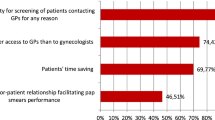Abstract
Background
The Family Medical Program is a health care system in the Rio de Janeiro state. Women’s health services offered by the Family Medical Program include preventive exams and screening, family planning, and prenatal follow-up. Although cervical cancer screening is offered, barriers to care still hinder the full success of the program, and we are attempting to identify these barriers.
Methods
We undertook a cross-sectional and prospective study involving 351 women who were referred to the Family Medical Program between March 2009 and November 2010. Demographic data were obtained through a structured household questionnaire. The dependent variable was defined as the non-realization of the Pap smear test following the protocol of the Health Ministry. Cervical samples for screening were collected after clinical examination.
Results
Women who had undergone Pap smear testing at least once every 3 years comprised 282 of the participants (80.3 %). Most of the women had normal or inflammatory cytology (96.3 %). Illiteracy and the absence of symptomatic episodes of sexually transmitted disease were independent barriers to having cancer screening at regular intervals. Illiterate women were more likely to be older, not to be using any contraceptive method, and on average had more than two children, more than four pregnancies, and more than two abortions. Embarrassment was the greatest barrier to seeking professional care reported by all women, regardless of level of educational attainment. Other important barriers to seeking care and/or screening included time constraints, due to work or childcare.
Conclusion
This study indicates that the Family Medical Program effectively provides cervical cancer screening coverage for its eligible population, at the level mandated by the WHO and the Brazilian Health Ministry. Fully 96.3 % of the women in our study had normal or benign inflammation on cytology. Understanding of barriers to care-seeking behavior that limit program adherence is one way to facilitate communication between providers and patients regarding the benefits of cancer screening.
Similar content being viewed by others
References
Health Ministry, Cancer National Institute (INCA) (2009) http://www.inca.gov.br//estimative//2010. Accessed 11 October 2009
Pereira CR, Rosa ML, Vasconcelos GA et al (2007) Human papillomavirus prevalence and predictors for cervical cancer among high-risk women from Rio de Janeiro, Brazil. Int J Gynecol Cancer 17:651–660
Elovainio L, Nieminen P, Miller AB (1997) Impact of cancer screening on women's health. Int J Gynecol Obstet 58:137–147
WHO (2002) Cervical cancer screening in developing countries: report of a WHO consultation. Programme organization. WHO, Geneva
e Silva GA, Girianelli VR, Gamarra CJ, Bustamante-Teixeira MT (2010) Cervical cancer mortality trends in Brazil, 1981–2006. Cad Saude Pública 26:2399–2407
ACOG Committee (2003) ACOG practice bulletin: clinical manager guidelines for obstetrician–gynecologists. Cervical cytology screening (replaces committee opinion 152, March 1995). Obstet Gynecol 102:417–427
Health Ministry, Cancer National Institute (INCA) (2011) Falando sobre o cancer do colo do útero 2002. Coordenação de prevenção e vigilância HM-INCA, p 59. http://www2.inca.gov.br. Accessed 17 Mar 2011
Teixeira SCS, Monteiro VO, Miranda VA (1999) Programa médico de família no município de Niterói. Estudos Avançados 13(35):147–155
Pinho AA, Junior IF, Schrber LB, D’ Oliveira AFPL (2003) Cervical cancer screening in the municipality of São Paulo: coverage and factors involved in submitting to the Pap test. Cad Saúde Pública 19:S303–S313
Rafael RMR, Moura ATMS (2010) Barriers to implementation of cervical cancer screening: a household survey in the coverage area of the family health program in Nova Iguaçu, Rio de Janeiro State. Brazil Cad Saúde Pública 26:1045–1050
Solomon D, Davey D, Kurman R et al (2002) The 2001 Bethesda system: terminology for reporting results of cervical cytology. J Am Med Assoc 287:2114–2119
Novaes HMD, Braga PE, Schout D (2006) Factors associated to the performance of preventive cancer exams in Brazilian women, PNAD 2003. Cad Saúde Coletiva 11:1023–1033
Albuquerque KM, Frias PG, Andrade CLT et al (2009) Pap smear coverage and factors associated with non-participation in cervical cancer screening: an analysis of the cervical cancer prevention program in Pernambuco State. Brazil Cad Saúde Pública 25:S301–S309
Silva KC, Rosa ML, Moyses N et al (2009) Risk factors associated with human papillomavirus infection in two populations from Rio de Janeiro, Brazil. Mem Inst Oswaldo Cruz 104:885–891
Moreira ED, Oliveira BG, Ferraz FM et al (2006) Knowledge and attitudes about human papillomavirus, Pap smears, and cervical cancer among young women in Brazil: implications for health education and prevention. Int J Gynecol Cancer 16:599–603
Byrd TL, Chavez R, Wilson KM (2007) Barriers and facilitators of cervical cancer screening among Hispanic women. Ethn Dis 17:129–134
Cheng HH, Chao A, Liao MN et al (2010) An exploration of Papanicolaou smear history and behavior of patients with newly diagnosed cervical cancer in Taiwan. Cancer Nurs 33:362–368
Woo JSJ, Brotto LA, Gorzalka BB (2009) The role of sexuality in cervical cancer screening among Chinese women. Health Psychol 28:598–604
Brenna SMF, Hardy E, Zeferino LC, Namura I (2001) Conhecimento, atitude e prática do exame de Papanicolaou em mulheres com câncer de colo uterino. Cad Saúde Pública 17:909–914
Amorim VMSL, Barros MBA, Cesar CLG et al (2006) Fatores associados à não-realização do exame de Papanicolaou: um estudo de base populacional no Município de Campinas, São Paulo, Brasil. Cad Saúde Pública 22:2329–2338
Cohen M (2002) Programa Médico de Família de Niteroi (Rio de Janeiro): uma alternativa urbana do Programa Saúde de Família. [The Family Medical Program of Niteroi (Rio de Janeiro): an urban alternative to the Family Health Program.] Saúde em Debate [Health in Debate] (Río de Janeiro, Brazil) 2002 May–August; 26(61):186–197
Acknowledgments
This work was supported by Pro-Reitoria de Pesquisa e Pós-Graduação da Universidade Federal Fluminense (PROPP-UFF), Conselho Nacional de Desenvolvimento Científico e Tecnológico (CNPq) and Fundação de Amparo à Pesquisa do Estado do Rio de Janeiro (FAPERJ).
Conflict of interest
None.
Author information
Authors and Affiliations
Corresponding author
Rights and permissions
About this article
Cite this article
Augusto, E.F., Rosa, M.L.G., Cavalcanti, S.M.B. et al. Barriers to cervical cancer screening in women attending the Family Medical Program in Niterói, Rio de Janeiro. Arch Gynecol Obstet 287, 53–58 (2013). https://doi.org/10.1007/s00404-012-2511-3
Received:
Accepted:
Published:
Issue Date:
DOI: https://doi.org/10.1007/s00404-012-2511-3




